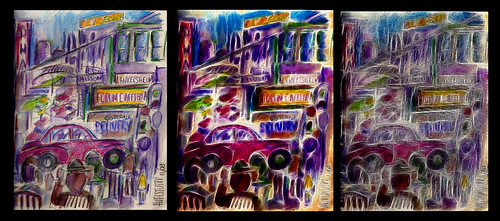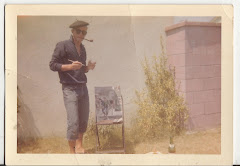THE ART ...
... of Robert Huffstutter
I have been intrigued with Robert's art for some time. I think he works mostly in colored pencil, but I could be wrong. It doesn't matter, what he basically works in is color on paper and his brain is too busy feeling the need to implant images and information on the paper, he is totally unconcerned with style and technique.
Robert is a pure natural painter. He's not a primitive as we defined that school of art from a long time ago. I would call Robert a naturalist, because he stays natural to not only his subject matter, but to himself. His is the kind of art that not only tells the message he is sending, but is magically therapeutic for him as well.
I know vocabulary is changed with time. My father would have studied about dementia praecox (sp), while I was told this title was obsolete and people could be paranoid or perhaps manic-depressive, but that dementia praecox no longer had meaning. Nowever Senile dementia is still a good descriptor.
Again, watch out for me, because I got my basic education over sixty years ago. Artistically children were grouped into two categories, visual and haptic. Visual people generally attempt to draw things as they visualize them, while haptic children tend to draw things as they FEEL them.
Robert is not totally haptic, because his layouts are all just the way you would see the subject matter, but on the other hand Robert strongly draws what he feels as well.
Here's an example of what a visual-haptic person can do. I watched this happen over the years with adults, trained and untrained, who were thus gifted.
Teaching adults for me was almost entirely for the night hours, so going out to sketch was impossible. I furnished a target image with a slide and projector. Most of the pictures I took of subject matter introduced was from either a kneeling or standing position and looking straight on at the subject. That usually placed the horizon line low or midway in the center of interest.
The haptic person, might be expected to do anything under the sun, whereas the visual person would usually do the expected layout and the teacher needed only to show them how to set up and correct the perspective and how to measure distances and comparisons and with a lot of practice a student could soon be drawing very realistic things.
Now, comes along a visual/haptic person and they do a very visual house the only thing is they draw the house they are looking straight into as if they were on the second floor of a house across the street and hence are not looking AT the house but DOWN ONTO the house. And, of course I stood there appalled. I mulled over the phenomenon over many years and never ever tried to tell the person not to do that.
What they were doing was a perspective project, so complicated, had I required a first semester drawing class to do it would have caused them to walk out on me. That kind of ability is one of the main things about a visual/haptic person.
I learned that as you begin to draw, you start work on the right side of your mind, very methodically doing everything very meticulously and thought-out. Then somewhere along the line, you began to paint automatically and become consciously unaware of the forces working within your mind. Here is where the miracles come from. Sometimes a sentenced ending in a preposition imparts great wisdom. Koff koff,
That stage is where the haptic person is all the time. They are working on the opposite side of their brains. Everything is emotional and everything is just as they want it to be. They have already arrived at style and technique. They are already purely original, as purely as an artist can be.
Visual/haptics, or what I call naturalists (a bad title because it sounds like they're collecting butterflies or bugs). Haptics and visual/haptics both resist training and the reason is they are doing what they came to do. They are not trying to develop a style, a technique or any of the words we use to describe painting and painters. They have arrived and just want to be free to work. They begin every picture on the opposite side of their brain and end it the same way. Actually, I think the visual/haptic has no dividing line and simply lives in a perfect blend of the two conditions or perhaps, they automatically flip back and forth from one brain hemisphere to the other.
I've told this badly, but I hope I've given you a new understanding into the kinds of artists we have amongst us.
Vaya con Dios, Roberto....
... as I meander through Robert's photostream, I always have the urge to CHANGE something, not improve and not correct, simply change it, so that now you have TWO to look at from time to time. Robert welcomes this kind of collaboration. I looked at his view (image on the left) of an LA street from a hotel lobby and thought about it with a GLOW all around the edges (image in the middle), then I wondered what if the glow "whispered" instead of spoke out loud (image on the right).
Here's a link to Robert/s photostream ...
Monday, October 10, 2011
THE ART ...
Subscribe to:
Post Comments (Atom)










No comments:
Post a Comment